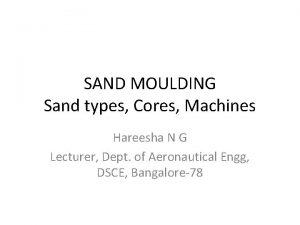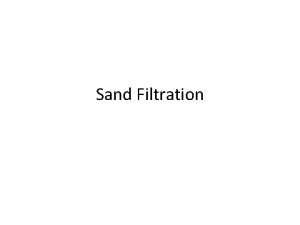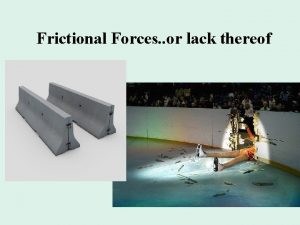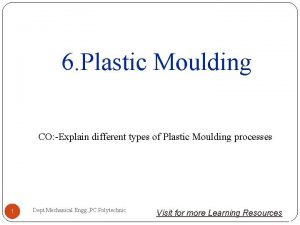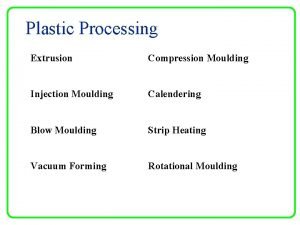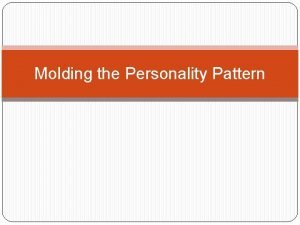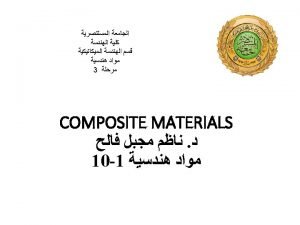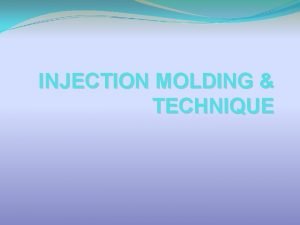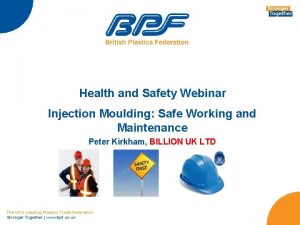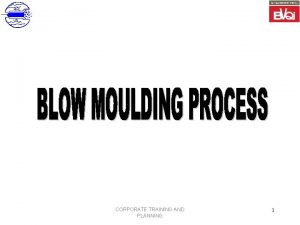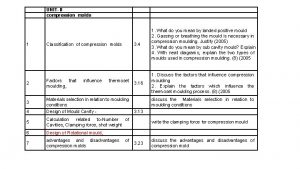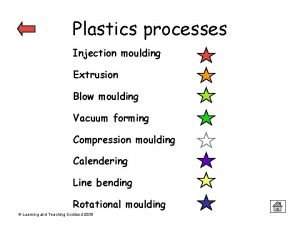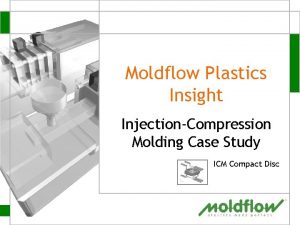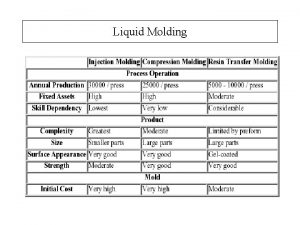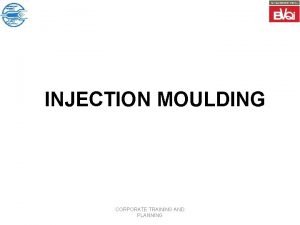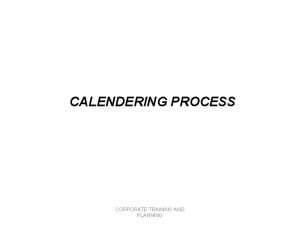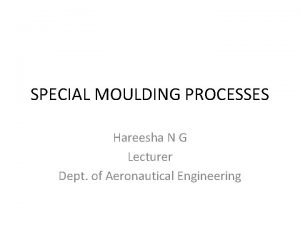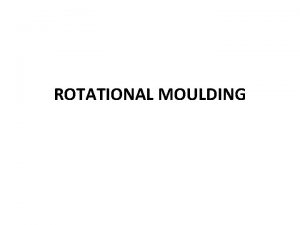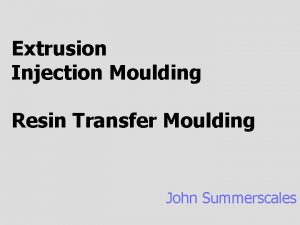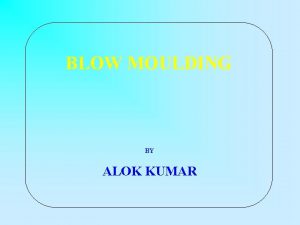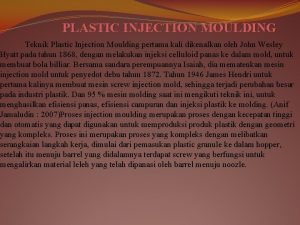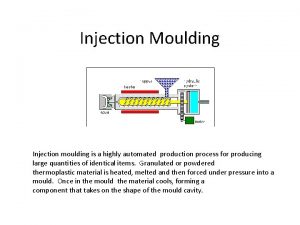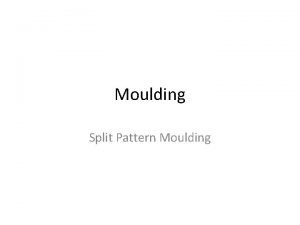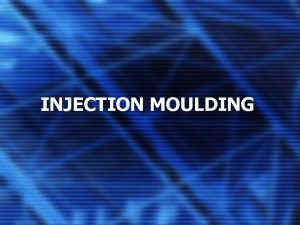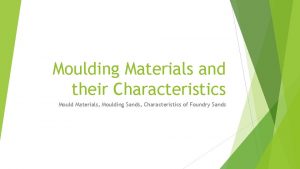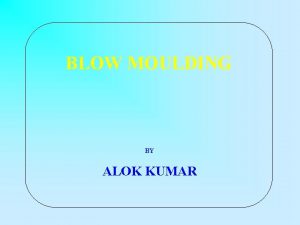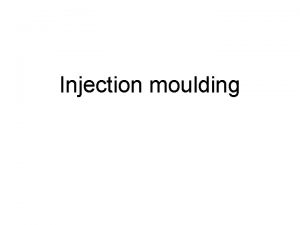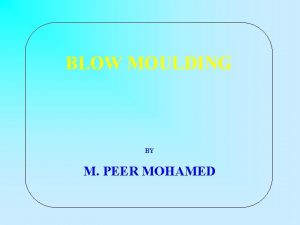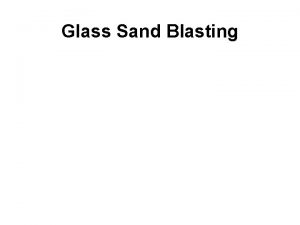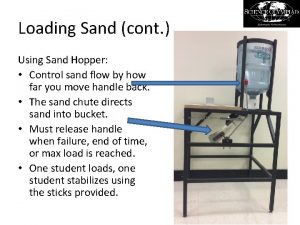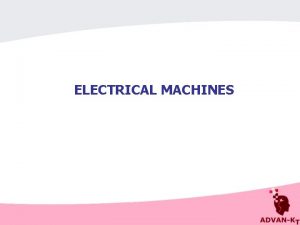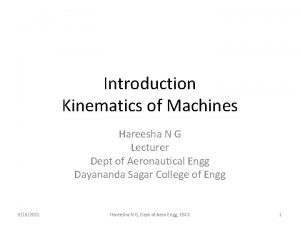SAND MOULDING Sand types Cores Machines Hareesha N




















- Slides: 20

SAND MOULDING Sand types, Cores, Machines Hareesha N G Lecturer, Dept. of Aeronautical Engg, DSCE, Bangalore-78

3. Parting line side gate • In parting line gates, the liquid metal enters the mold cavity from the side of the mold (cavity) at the parting line separating cope and drag at or the level of mold joint. • Examples of parting line gates are shown in Fig. • Parting line gate can be made by the pattern itself or it can be cut afterwards. • As regards fluid flow, parting line gates stand in between top and bottom gates. • A parting line gate has sprue formed in the (sand of the) cope. • A recess is generally provided at the base of the sprue to avoid the cutting of sand at this place.

Advantages of Parting Line Gating • Parting line gates are simple to construct. • Parting line gates are very fast to make. • Parting line gates produce very satisfactory results when drag is not very deep. • Parting line gating makes best compromise between molding convenience and the ideal gating arrangement. Disadvantages of Parting Line Gating • In case the parting line is not near the bottom of the mold cavity or the drag portion is deep, some turbulence will occur as the liquid metal falls into the mold cavity. • Cascading (Spilling) of molten metal from a height in the mold cavity will cause erosion or washing of the mold. • Cascading in non-ferrous metals will promote air pickup by the liquid metal and thus result in an inferior casting.

PRINCIPLES OF RISERING Definition • • A riser or a feeder head is a passage of sand made in the cope (mold) during ramming the cope. The molten metal rises in the feeder head after the mold cavity is filled up. This metal in the feeder head (or riser) compensates the shrinkage as the casting solidifies. Fig. shows a riser. Functions of Riser • • • Metals and their alloys shrink as they cool and solidify. It creates a partial vacuum within the casting. Partial vacuum leads to a shrinkage void. This shrinkage void will grow and form shrinkage cavity if extra liquid metal from outside the mold (cavity) is not supplied. The primary function of the riser (attached with the mold) is to feed metal to the solidifying casting so that shrinkage cavities are get rid of. A riser permits the escape of air and mold gases as the mold cavity is being filled with the molten metal. A riser full of molten metal indicates that the mold cavity has already been completely filled up with the same. A casting solidifying under the liquid metal pressure of the riser is comparatively sound. Risers promote directional solidification.

TYPES OF RISERS 1. 2. Open Riser Blind Riser 1. Open Riser It is shown in Fig (top riser). Open Riser The top of the open riser is open i. e. , exposed to atmosphere. • The liquid metal in the riser is fed to the solidifying casting under force of gravity and atmospheric pressure till the top surface of the riser solidifies and thereafter gravity is only the feeding force. • An open riser is connected either at the top of cope, or on the side at the parting line. • An open riser is generally cylindrical. Advantages • An open riser is easy to mold as compared to a blind riser. • An open riser is open to atmosphere, thus it ensures that unlike a blind riser it will not draw metal from the casting as a result of partial vacuum in the riser. Limitations • Open riser is not placed in the drag. • Open riser is generally larger than a comparable blind riser. • An open riser is more difficult to remove from the casting as compared to blind riser. • •

2. Blind Riser A blind riser is closed at its top; however, a vent or permeable core at the top of the riser may be provided to have some exposure to the atmosphere otherwise the vacuum created between the top of the riser and the liquid metal level in the riser may not permit proper feeding of liquid metal from riser to the casting. Gravity is the only Blind Riser feeding force. • A blind riser is connected, either at the top of cope, or on the side of the casting at the parting line or in the drag. • A blind riser is a rounded cavity and it represents the minimum practical ratio of surface area to volume and thus associates a slow cooling rate and is more efficient. • Advantages • • Blind risers can be placed at any position in the mold. A blind riser is smaller than a comparable open riser. A blind riser can be removed more easily from a casting. Blind risering promotes directional solidification better than the open risering. Limitations • • It is difficult to mold a blind riser. A blind riser may draw liquid metal from the solidifying casting.

FETTLING & CLEANING OF CASTINGS Fettling is the name given to cover all those operations which help giving the casting a good appearance after the same has been shaken out of the sand mold. • Fettling includes • 1. Removal of cores from the casting. 2. Removal of adhering sand oxide scale from the casting surface (surface cleaning). 3. Removal of gates, risers, runners etc. from the casting. 4. Removal of fins, and other unwanted projections from the castings. 1. Removal of Cores • It may be difficult to remove dry sand hardened cores in the absence of suitable equipment. • Hammering or vibrations imparted to cores does loosen and break them up. • Sand portions sticking inside the castings are removed by poking action using a metal rod. • Cores from larger castings may be removed effectively by pneumatic rapping and hydro blasting. .

2. Cleaning of Casting Surfaces • • • The outside and inside surfaces of castings are cleaned of adhering refractory (sand) particles and oxide scale and they (i. e. , surfaces) look smooth and pleasing. The extent of surface cleaning required depends upon the metal/ alloy of the casting and size of the casting. Steel castings (because of their high melting and pouring temperatures and consequent burning of the sand in contact with the molten metal) require considerable more cleaning than those of iron and brass. Aluminium castings are virtually free from burned-on sand. Since heavy castings suffer more than light castings from the burning-on of sand, their cleaning is more difficult. Sand may be removed from the surfaces of castings using hand methods or mechanical equipment 3. Removal of gates and risers • • Numerous methods are available for removing feeding and gating systems. The choice of a particular method depends upon the type of metal/alloy, — size of the casting, — size of runners, gates and risers. • A few commonly used methods are given below: 1. 2. 3. 4. 5. 6. 7. Chipping hammers Flogging (knocking off). Shearing. Sawing Abrasive wheel slitting Machining. Flame cutting.

4. REMOVAL OF FINS AND OTHER UNWANTED PROJECTIONS FROM CASTINGS • Castings are trimmed to remove fins, chaplets, wires, parting line and the stumps of feeder heads and ingates. All these unwanted projections are dressed flush with the surface. • The methods employed to remove unwanted projections from the castings are – – – – Chipping Sawing Flame cutting Flame gouging and flame scarfing. Grinding Abrasive belt machining Rotary tools cutting Trimming and sizing.

CASTING DEFECTS • Casting process involves a number of variables and a loss of control in any of these variables can cause defects under certain circumstances. • Some of the common casting defects, their features and remedies to prevent such defects are discussed below. 1. Shrinkage defect • Shrinkage is a void on the surface of the castings resulting from concentrated contraction or shrinkage of metal during solidification. Refer figure. • Although a riser is used to over come the shrinkage effect, in some cases it fails to feed the molten metal efficiently to the casting as it solidifies. Remedies • Use large sprue and riser to promote directional solidification. • Locate risers and gating systems in correct positions. • Gates to be cut as wide as possible.

2. Porosity defect (Blow hole and Pin hole) • Molten metal absorb gases from various sources such as fluxes, moisture in sand, binders, additives and normal atmospheric gases like oxygen and nitrogen. • If these gases are not allowed to escape, they get entrapped in the mould cavity forming small balloon shaped voids or cavities leading to porosity defect in castings. • Two types of gas related defects occur in castings. They are: – blow hole – pin hole defect. • Blow holes occur below the surface of the castings and are not visible from the outside surface. • Pin holes are small gas cavities, many in number at or slightly below the surface of the casting. Remedies • Avoid excess ramming of mould. • Provide proper vent holes. • Avoid use of excess carbonaceous or other organic material in the sand/core binders, because these materials react with the molten metal producing large amount of gases.

3. Misrun • Misrun occur when the mould cavity is not completely filled with molten metal. • it is a defect wherein a casting solidifies before the molten metal completely fills the cavity. Remedies • Fluidity of metal should be high. • Pouring rate and time should be controlled. • Thin sections should be suitable designed. 4. Penetration When fluidity of liquid metal is high, it may penetrate into the sand mould/core (into the voids between the sand particles) causing a fused aggregate of metal and sand on the surface of the casting leading to defect. Remedies • Sand should be properly rammed. . • Moulding sand/core sand should not be too coarse to promote metal penetration. • Control proper metal temperature.

5. Mould shift • It is a step in the cast product at the parting line caused by sidewise relative displacement of cope and drag box. Remedies • Proper alignment of cope and drag box. • Proper handling of assembled cope and drag box during operations. 6. Cold shut • Two portions of metal flow together, but lack of fusion due to premature freezing results in a defect known as cold shut. Remedies • Place gates and risers at proper locations. • Metal fluidity should be high. Mould shift Cold shut

7. Hot tears • A hot tear is an internal or external ragged discontinuity formed in the casting due to the pulling action of the metal just after it has solidified. Remedies • Provide adequate fillets at sharp corners. • Proper metallurgical and pouring temperature. • Place gates and risers at proper locations.

MOULDING MACHINES • When large number of castings is to be produced, hand moulding consumes more time, labour and also accuracy and uniformity in moulding varies. • To overcome this difficulty, machines are used for moulding. • Based on the methods of ramming, moulding machines are classified as follows: 1. 2. 3. 4. Jolt machine Squeeze machine Jolt-squeeze machine Sand slinger

1. Jolt Machine • A jolt machine consists of a flat table mounted on a piston-cylinder arrangement and can be raised or lowered by means of compressed air. • In operation, the mould box with the pattern and sand is placed on the table. The table is raised to a short distance and then dropped down under the influence of gravity against a solid bed plate. The action of raising and dropping (lowering) is called 'Jolting'. • Jolting causes the sand particles to get packed tightly above and around the pattern. The number of 'jolts' may vary depending on the size and hardness of the mould required. Usually, less than 20 jolts are sufficient for a good moulding. • The disadvantage of this type is that, the density and hardness of the rammed sand at the top of the mould box is less when compared to its bottom portions.

2. Squeeze Machine • In squeeze machine, the mould box with pattern and sand in it is placed on a fixed table as shown in figure • A flat plate or a rubber diaphragm is brought in contact with the upper surface of the loose sand pressure is applied by a pneumatically operated piston. • The squeezing action of the plate causes the sand particles to get packed tightly above and around the pattern. • Squeezing is continued until the mould attains the desired density. • In some machines, the squeeze plate may be stationary with the mould box moving upward. • The disadvantage of squeeze machine is that, the density and hardness of the rammed sand at the bottom of the mould box is less when compared to its top portions.

3. Jolt Squeeze Machine • Jolt squeeze machine combines the operating principles of 'jolt' and 'squeeze' machines resulting in uniform ramming of the sand in all portions of the moulds • The machine makes use of a match plate pattern placed between the cope and the drag box. • The whole assembly is placed on the table with the drag box on it. • The table is actuated by two pistons in air cylinders, one inside the other. One piston called 'Jolt piston' raises and drops the table repeatedly for a predetermined number of times, while the other piston called 'squeeze piston' pushes the table upward to squeeze the sand in the flask against the squeeze plate. In operation, sand is filled in the drag box and jolted repeatedly by operating the jolt piston. • After jolting, the complete mould assembly is rolled over by hand. • The cope is now filled with sand by operating the squeeze piston, the mould assembly is raised against the squeeze plate. By the end of this operation, the sand in the mould box is uniformly packed. • The match plate is now vibrated and removed. The mould is finished and made ready for pouring.

4. Sand slinger • A sand slinger is an automatic machine equipped with a unit that throws sand rapidly and with great force into the mould box. Figure shows a sand slinger. Sand slinger consists of a rigid base, sand bin, bucket elevator, belt conveyor, ramming head (sand impeller) and a swinging arm. • In operation, the pre-mixed sand mixture from the sand bin is picked by the bucket elevator and is dropped on to the belt conveyor. • The conveyor carries the sand to the ramming head, inside which there is a rotating impeller having cup shaped blades rotating at high speeds (around 1800 rpm).

• The force of the rotor blades imparts velocity to the sand particles and as a result the sand is thrown with very high velocity into the mould box thereby filling and ramming the sand at the same time. • The density of the ramming sand can be controlled by varying the speed of the impeller. Rest of the operations, viz. , removal of pattern, cutting gates etc. , are done manually. • In the initial stages of ramming, the blades are rotated at slow speeds; around 1000 - 1200 rpm to avoid damage to the pattern due to the abrasive action of the high velocity sand particles.
 Drop core
Drop core Dry sand casting
Dry sand casting Perbedaan rapid sand filter dan slow sand filter
Perbedaan rapid sand filter dan slow sand filter Frictional unemployment
Frictional unemployment Difference between rapid sand filter and slow sand filter
Difference between rapid sand filter and slow sand filter Two types of plastic
Two types of plastic Defects in blow molding products
Defects in blow molding products Calendering moulding
Calendering moulding Plays an important role in molding the personality
Plays an important role in molding the personality Resin transfer molding
Resin transfer molding Cold slug well
Cold slug well Empire blow mold history
Empire blow mold history Mould loading and unloading procedure
Mould loading and unloading procedure Blow moulding training
Blow moulding training Compression and transfer moulding
Compression and transfer moulding Bulk factor in compression moulding
Bulk factor in compression moulding Calendering moulding process
Calendering moulding process Moldflow plastic insight
Moldflow plastic insight Sqrtm - same-qualified resin transfer moulding
Sqrtm - same-qualified resin transfer moulding Toggle system
Toggle system Advantages of calendering process
Advantages of calendering process
